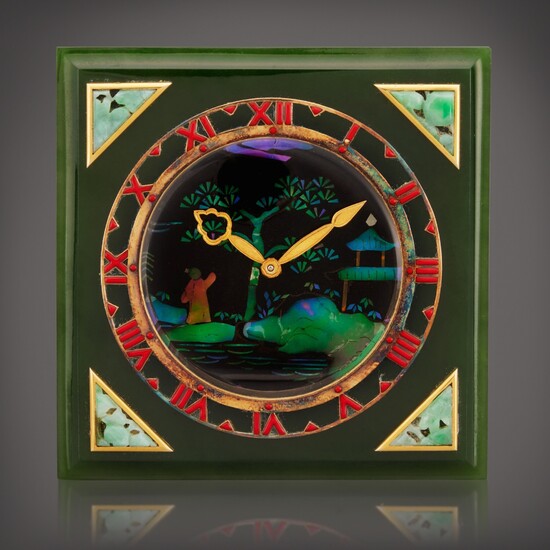Cartier, Paris A jade, gold, enamel, and mother-of-pearl desk timepiece, Circa 1920 | 巴黎卡地亞 玉石、黃金、琺瑯及珠母貝座鐘,製作年份約 1920
Cartier, Paris
A jade, gold, enamel, and mother-of-pearl desk timepiece, Circa 1920
巴黎卡地亞 玉石、黃金、琺瑯及珠母貝座鐘,製作年份約 1920
Dial: laque burgauté panel depicting a Chinoiserie scene
Caliber: mechanical
Case: open work chapter ring with red enamel Roman numerals, the nephrite molded square case including four carved jadeite spandrels within gold frames, gilt metal case back and easel stand
Case number: stand signed Cartier 2146 Paris, case back stamped 0671
Size: 74 mm width
Box: no
Papers: no
Condition Report:
Case: The case is in overall very good condition. The jade remains intact. Small area of chipping to the bottom left jadeite spandrel. Visible oxidation to the gold chapter ring. Gilt finish on the case back with area of wear around the winding stem.
Dial: The mother-of-pearl with some hairlines and minor losses.
Movement: The movement is running at time of cataloging, however it was not tested for the accuracy of time or duration of the power reserve and may need service at the buyer's discretion. Please note that Sotheby's does not guarantee the future working of the movement.
***Please note that this lot requires CITES and/or FISH & WILDLIFE permits for international export.***
Catalogue Note:
The present lot is inspired by the Far East and features a attractive laque burgauté dial depicting a Scholar in his garden. Laque burgauté refers to the exquisite East Asian technique of decorating lacquer with intricate inlays of tinted mother-of-pearl, often engraved and combined with gold and silver foil. The technique probably originated in China as early as the Ming Dynasty (1368-1644) and was very popular during the Qing dynasty (1644-1911/12) and spread to the Ryukyu Islands between China and Japan and thence to Japan itself. In China the technique is called 'lo tien' and in Japan, 'aogai'. The Western name is derived from the French - sea-ear or mussel (burgau) and lacquer (laque or lac). Most of the lacquer used by Cartier in their art deco objects is likely to have been made in Ryukyu or in Japan.
For similar examples of Cartier desk timepieces of Chinese inspiration, see Barracca, J., Negretti, G. and Nencini, F., Le Temps de Cartier, pp. 108, 167, 169, 172-3 and 176.
View it on
Sale price
Estimate
Time, Location
Auction House
Cartier, Paris
A jade, gold, enamel, and mother-of-pearl desk timepiece, Circa 1920
巴黎卡地亞 玉石、黃金、琺瑯及珠母貝座鐘,製作年份約 1920
Dial: laque burgauté panel depicting a Chinoiserie scene
Caliber: mechanical
Case: open work chapter ring with red enamel Roman numerals, the nephrite molded square case including four carved jadeite spandrels within gold frames, gilt metal case back and easel stand
Case number: stand signed Cartier 2146 Paris, case back stamped 0671
Size: 74 mm width
Box: no
Papers: no
Condition Report:
Case: The case is in overall very good condition. The jade remains intact. Small area of chipping to the bottom left jadeite spandrel. Visible oxidation to the gold chapter ring. Gilt finish on the case back with area of wear around the winding stem.
Dial: The mother-of-pearl with some hairlines and minor losses.
Movement: The movement is running at time of cataloging, however it was not tested for the accuracy of time or duration of the power reserve and may need service at the buyer's discretion. Please note that Sotheby's does not guarantee the future working of the movement.
***Please note that this lot requires CITES and/or FISH & WILDLIFE permits for international export.***
Catalogue Note:
The present lot is inspired by the Far East and features a attractive laque burgauté dial depicting a Scholar in his garden. Laque burgauté refers to the exquisite East Asian technique of decorating lacquer with intricate inlays of tinted mother-of-pearl, often engraved and combined with gold and silver foil. The technique probably originated in China as early as the Ming Dynasty (1368-1644) and was very popular during the Qing dynasty (1644-1911/12) and spread to the Ryukyu Islands between China and Japan and thence to Japan itself. In China the technique is called 'lo tien' and in Japan, 'aogai'. The Western name is derived from the French - sea-ear or mussel (burgau) and lacquer (laque or lac). Most of the lacquer used by Cartier in their art deco objects is likely to have been made in Ryukyu or in Japan.
For similar examples of Cartier desk timepieces of Chinese inspiration, see Barracca, J., Negretti, G. and Nencini, F., Le Temps de Cartier, pp. 108, 167, 169, 172-3 and 176.



